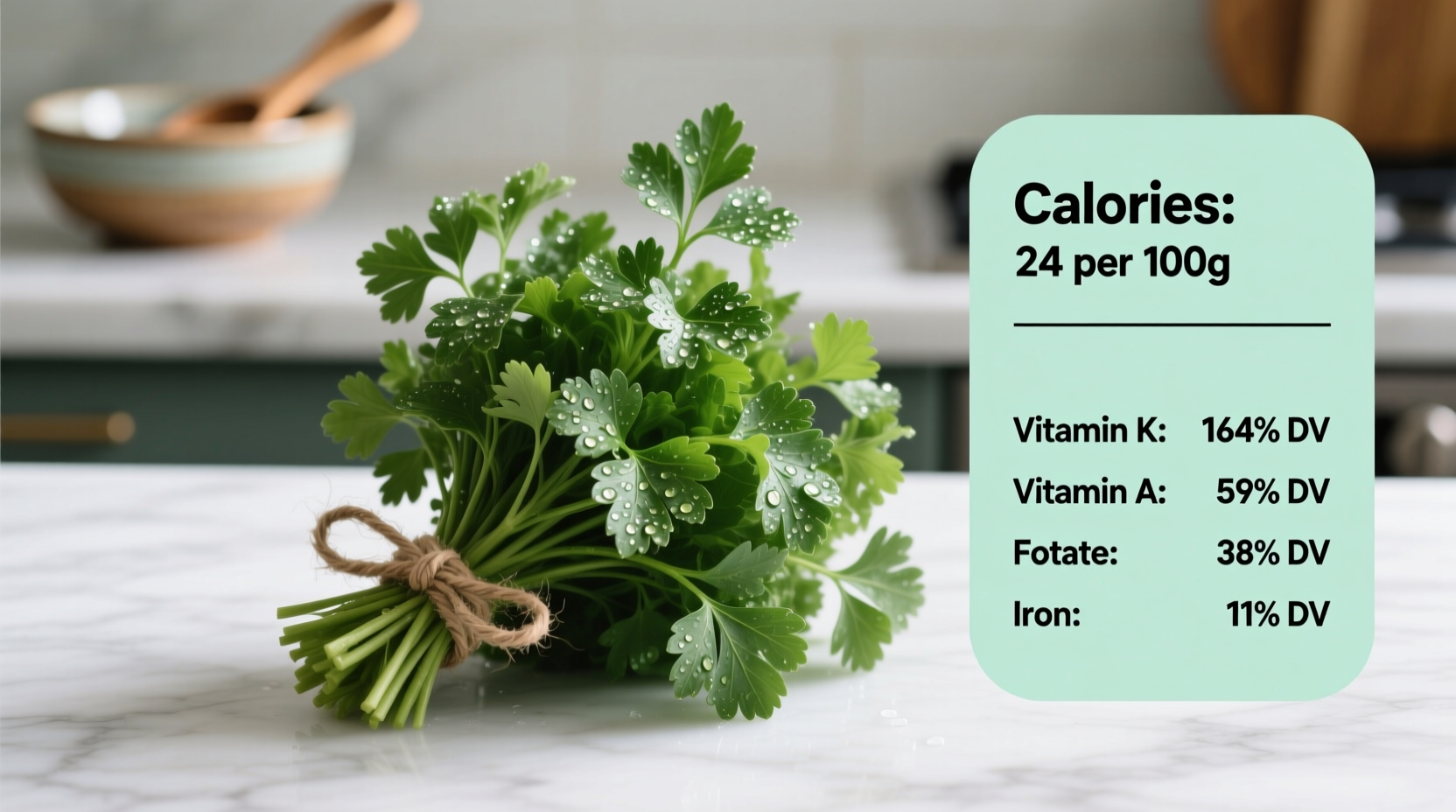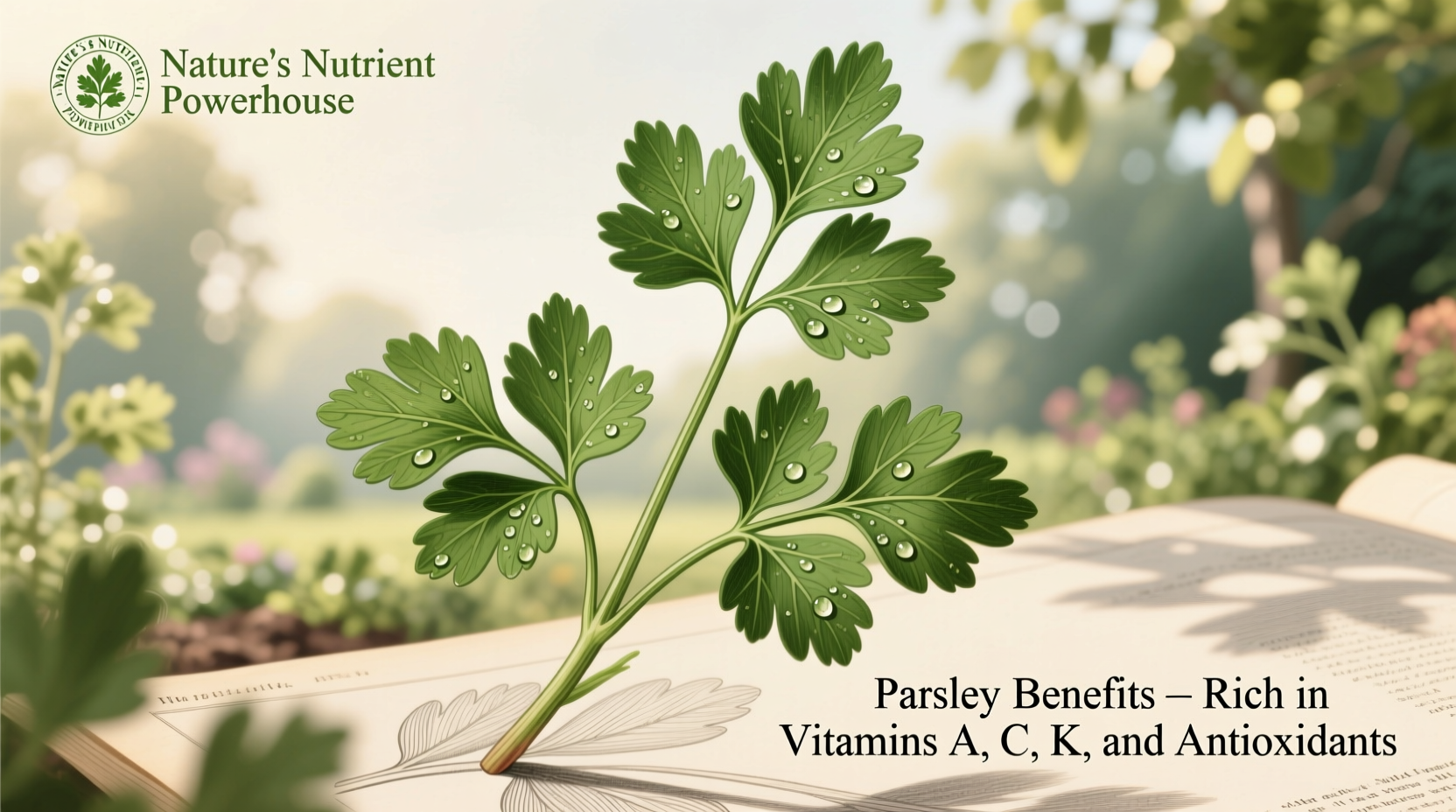Most people dismiss parsley as mere plate decoration, but this vibrant green herb packs a remarkable nutritional punch that deserves a starring role in your kitchen. Beyond its fresh flavor, parsley contains concentrated levels of essential nutrients that contribute to multiple aspects of health when incorporated consistently into your meals.
Nutritional Powerhouse in Every Sprig
What makes parsley stand out among culinary herbs? Its extraordinary nutrient density. While often used sparingly as garnish, even small amounts deliver meaningful nutritional benefits. A single cup (60g) of fresh parsley provides:
| Nutrient | Amount per Cup | Daily Value % | Key Functions |
|---|---|---|---|
| Vitamin K | 1,230 mcg | 1,025% | Bone metabolism, blood clotting |
| Vitamin C | 133 mg | 148% | Immune function, antioxidant protection |
| Vitamin A | 8,424 IU | 168% | Vision health, immune support |
| Folate | 108 mcg | 27% | Cellular function, DNA synthesis |
| Iron | 4.0 mg | 22% | Oxygen transport, energy production |
This nutritional profile surpasses many common fruits and vegetables by weight. In fact, gram for gram, parsley contains nearly three times more vitamin C than oranges and more beta-carotene than carrots. The herb's deep green color signals its rich chlorophyll content, which has demonstrated detoxification properties in clinical studies.

Science-Backed Health Benefits
Modern research continues to validate traditional uses of parsley, revealing specific mechanisms behind its health-promoting properties.
Cardiovascular Support System
Parsley's impressive combination of vitamin K, folate, and antioxidants contributes significantly to heart health. Vitamin K2, abundant in parsley, helps prevent calcium buildup in arteries—a process known as vascular calcification. A 2020 study published in Nutrients followed 4,000 participants over 10 years and found those with highest vitamin K2 intake had 52% lower risk of severe arterial calcification compared to those with lowest intake (NIH Study).
The herb's high nitrate content also converts to nitric oxide in the body, which helps relax blood vessels and maintain healthy blood pressure levels. Unlike processed nitrates, the natural nitrates in parsley work synergistically with its antioxidants to provide cardiovascular benefits without negative side effects.
Bone Density Preservation
Vitamin K's role extends far beyond blood clotting—it's essential for bone metabolism. The vitamin activates osteocalcin, a protein that binds calcium to the bone matrix. Research from the Framingham Heart Study demonstrated that individuals with vitamin K deficiency had significantly lower bone mineral density and higher fracture risk.
One cup of parsley provides more than ten times the recommended daily intake of vitamin K—making it one of nature's most concentrated sources. For perspective, this same serving contains approximately 1,230 micrograms of vitamin K, while the recommended daily amount for adults is just 90-120 micrograms.
Natural Anti-Inflammatory Effects
Parsley contains several potent anti-inflammatory compounds, including flavonoids like apigenin and luteolin. These compounds inhibit inflammatory pathways in the body at the cellular level. A 2019 laboratory study published in Phytotherapy Research showed that parsley extract significantly reduced markers of inflammation in human cell cultures (Wiley Study).
Regular consumption of parsley may help manage chronic inflammation associated with conditions like arthritis, metabolic syndrome, and other inflammatory disorders. The herb's combination of vitamin C, beta-carotene, and flavonoids creates a synergistic antioxidant effect that protects cells from oxidative damage.
Practical Integration into Daily Eating
To maximize parsley's health benefits, consider these evidence-based usage strategies:
Optimal Preparation Methods
Raw parsley preserves maximum nutrient content, particularly vitamin C which degrades with heat. However, light cooking can increase the bioavailability of certain carotenoids. For best results:
- Use fresh parsley as a finishing herb rather than cooking it extensively
- Chop parsley finely to release maximum nutrients
- Combine with healthy fats (like olive oil) to enhance absorption of fat-soluble vitamins
- Add to dishes just before serving to preserve vitamin content
Daily Consumption Guidelines
While parsley is safe for most people in culinary amounts, research suggests these optimal consumption levels:
- Maintenance level: 1-2 tablespoons chopped daily
- Therapeutic level: 1/4 to 1/2 cup in salads or smoothies
- Maximum safe daily amount: Approximately 1 cup (studies show no adverse effects at this level)
For those specifically targeting vitamin K benefits for bone health, consuming just two tablespoons daily provides sufficient vitamin K without exceeding recommended levels.
Safety Considerations and Limitations
Parsley is generally safe when consumed in normal food amounts, but certain considerations apply:
- People taking blood-thinning medications like warfarin should maintain consistent parsley intake, as vitamin K affects blood clotting
- Those with kidney disease should moderate consumption due to parsley's potassium content
- Pregnant women should avoid medicinal amounts (supplements or large quantities of parsley tea)
- Rare cases of allergic reactions have been documented, particularly in those sensitive to other Apiaceae family plants
Unlike many supplements, parsley offers nutrients in their natural, food-based forms with built-in cofactors that enhance absorption and reduce risk of imbalances. The herb's nutrient profile works synergistically, making it more beneficial than isolated supplements.
Parsley Through the Ages: Historical Usage Timeline
Parsley's medicinal use spans centuries, with documented applications evolving alongside scientific understanding:
- Ancient Greece (500 BCE): Used as victory wreaths and for medicinal purposes, particularly for kidney and digestive issues
- Roman Era: Employed as a diuretic and to freshen breath after meals
- Middle Ages: Recognized in European herbals for treating jaundice and intestinal worms
- 19th Century: Documented in medical texts for treating urinary tract infections
- 1950s: Vitamin K content identified and linked to blood clotting mechanisms
- 2000s-Present: Modern research confirms antioxidant, anti-inflammatory, and cardiovascular benefits through clinical studies
This historical progression demonstrates how traditional knowledge often precedes scientific validation—a pattern increasingly confirmed by contemporary nutritional research.
Real-World Application Scenarios
Understanding when parsley delivers maximum benefit helps optimize its use:
- Post-workout recovery: The combination of vitamin C and anti-inflammatory compounds makes parsley an excellent addition to post-exercise smoothies
- Bone health maintenance: Regular consumption supports bone density, particularly important for postmenopausal women
- Detoxification support: Chlorophyll content helps neutralize certain environmental toxins
- Digestive aid: Natural enzymes in parsley support healthy digestion when consumed with meals
However, parsley shouldn't be viewed as a standalone solution. Its benefits are most pronounced when incorporated into a varied, nutrient-dense diet rather than consumed in isolation.
Comparative Herb Analysis
How does parsley stack up against other common culinary herbs?
| Herb | Vitamin K (mcg/cup) | Vitamin C (mg/cup) | Unique Compounds | Best Culinary Uses |
|---|---|---|---|---|
| Parsley | 1,230 | 133 | Apiol, Myristicin | Versatile—salads, sauces, garnishes |
| Cilantro | 310 | 27 | Coriandrin | Mexican, Asian dishes, salsas |
| Basil | 140 | 18 | Eugenol, Linalool | Pasta sauces, caprese salads |
| Mint | 180 | 26 | Menthol | Desserts, teas, Middle Eastern dishes |
While all these herbs offer health benefits, parsley stands out for its exceptional vitamin K and C content. For those specifically targeting bone health or antioxidant intake, parsley provides significantly higher concentrations of these critical nutrients compared to alternatives.











 浙公网安备
33010002000092号
浙公网安备
33010002000092号 浙B2-20120091-4
浙B2-20120091-4